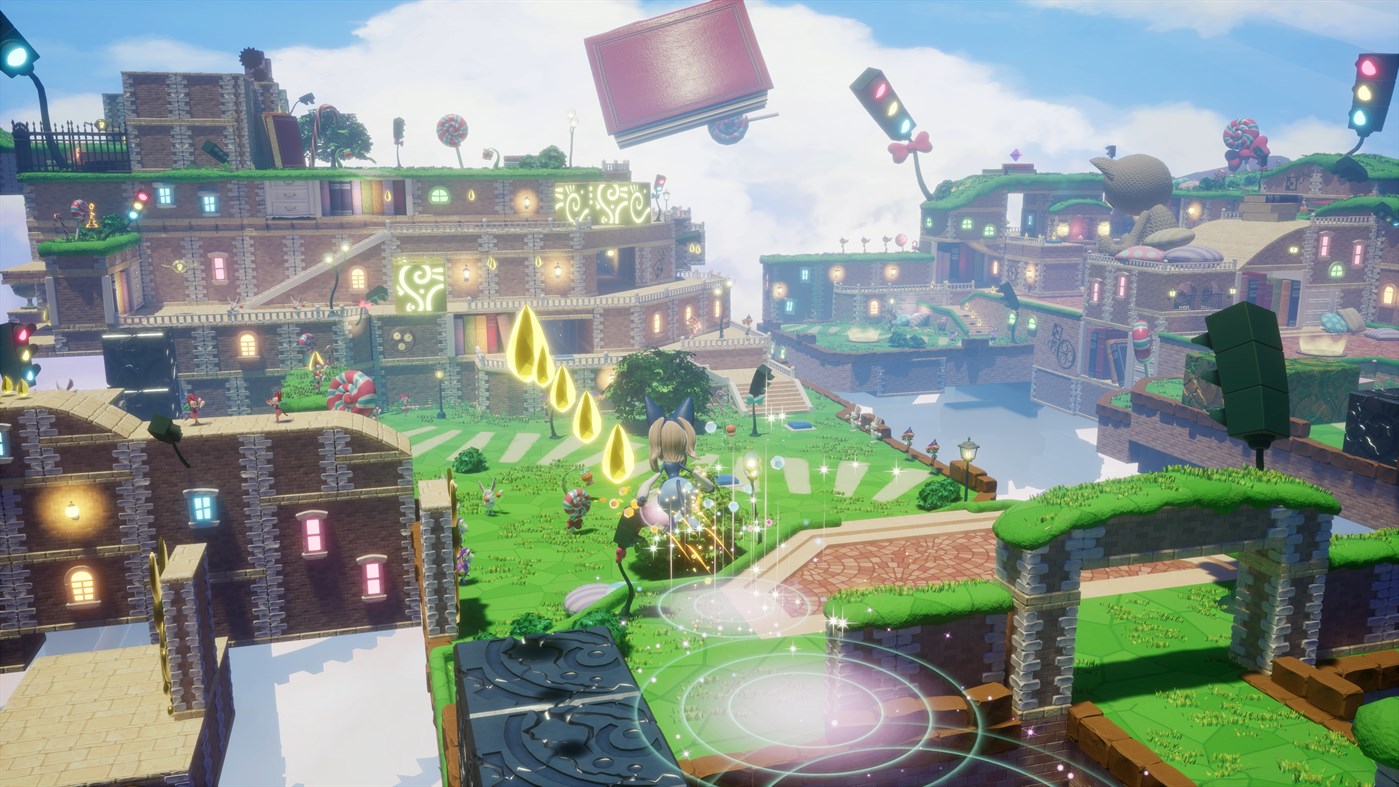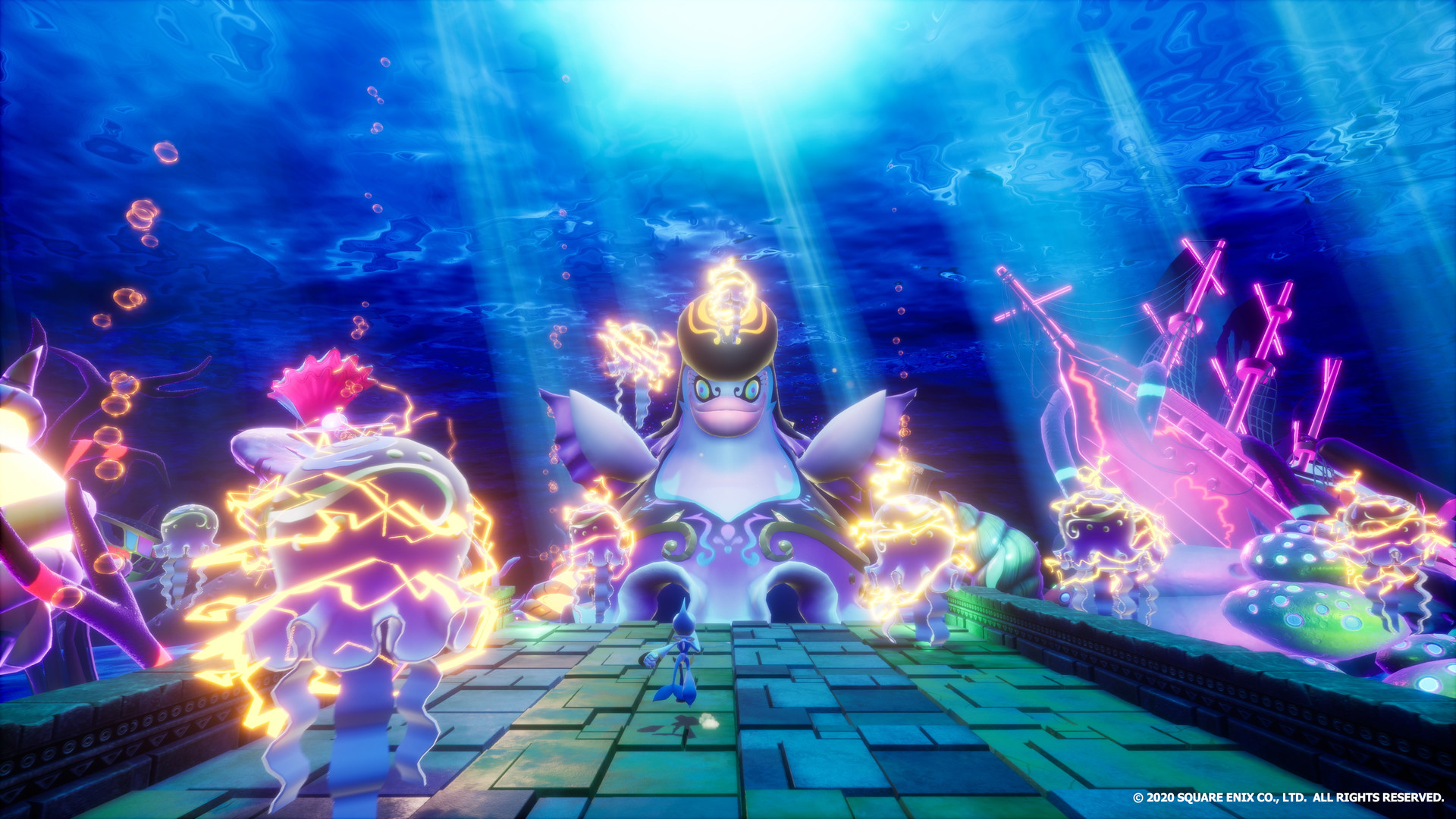
Playing Balan Wonderworld is a lot less entertaining than it should be. On paper, and even in the run up to its release, it seemed like there are a lot of things about it that should give it a jolt of enjoyability, catharsis, and nostalgia for a long history of costume-based platformers, especially as it’s helmed by Yuji Naka, one of the original creators of Sonic. While the aspects of the game you’d expect to amplify the experience are there in pieces, Balan Wonderworld instead fails on a larger front to create an engaging long-term gameplay loop. Its lack of continuity and failed attempts to create a multifaceted experience means that its appeal is far wider than it is deep, and it tries to juggle too many unrelated pieces to ever really find its footing.
Immediate comparisons don’t flatter Balan Wonderworld. Even though it comes from the creator of Sonic, it takes the clearest inspiration from many recent 3D Mario games, most evidently Super Mario Odyssey, and the comparisons are as unflattering as they are inevitable. In most instances, Wonderworld plays it straight as a 3D platformer challenging you to use the different abilities of the playable character to collect various items hidden around each level and defeat bosses to progress. The platforming isn’t as tight or precise as many modern peers of the genre, but if you can tame the often-unpredictable camera, it’s inoffensive enough on its own.
"In most instances, Balan Wonderworld plays it straight as a 3D platformer challenging you to use the different abilities of the playable character to collect various items hidden around each level and defeat bosses to progress. The platforming isn’t as tight or precise as many modern peers of the genre, but if you can tame the often-unpredictable camera, it’s inoffensive enough on its own."
Everything you do in Balan Wonderworld is contextualized with a cheerful story about overcoming inner demons. There are twelve cabaret-inspired chapters, each of which contains two stages, a boss, and a third stage unlocked after you complete everything once through. While they’re diverse in design, they all maintain the same cheerfulness, with consistently bright colors and dancing NPCs. They don’t always push the limits of the hardware, but the art style is easy enough on the eyes. The opening cutscene portrays your character getting laughed off a basketball court and taken in by a mysterious man in a big top hat, and you’re then transported into this unexplained new world. It’s nearly incomprehensible at points, with cutscenes loosely related to the worlds you’ve completed, though the most interesting aspects are the impossible-to-hate showtune-like musical numbers that come after you beat a boss. It all gives off an air of unwavering positivity that’s a breath of fresh air in a lot of ways, but it only does so much to hold up the gameplay.
The game’s primary unique offering is its abundance of costumes, which offer different abilities to the wearer to solve puzzles, and which are littered throughout to allow the player the agency to choose which costumes to wear. But while the idea behind the costumes is well enough in concept, its execution leaves a lot to be desired. You can only hold up to three costumes at a time, and it frustratingly doesn’t restrict you from holding the same costume more than once. Frequently I ran into the problem of losing a costume I was saving to solve a specific puzzle because I accidentally gathered one I already was wearing. What’s more is that to acquire a costume you have to use a key found around the world, but the game never makes an effort to utilize this concept, so keys are almost always very close to the costume pick-ups. Even in boss fights, the game showers you with keys so you have no trouble picking up the costumes when necessary, forcing the question of why the keys are in the game in the first place.
There are dozens of costumes to find overall, most of which are well-designed and cosmetically diverse to match their stage. When it comes down to it, though, there aren’t enough unique abilities to justify having this many costumes. They all only have one ability, most of which are repeated at some point somewhere else, and those that aren’t repeated are generally specific to their original stage. Because they each allow just a single ability, many costumes don’t allow the ability to jump, which forces you to hold a spot for one that can jump, as almost every segment of every stage requires it. It’s a baffling design choice, and one wonders why so many costumes were necessary if they weren’t going to be entirely unique, as they become cumbersome and overwhelming to manage, especially in later levels.
"The game’s primary unique offering is its abundance of costumes, which offer different abilities to the wearer to solve puzzles, and which are littered throughout to allow the player the agency to choose which costumes to wear. But while the idea behind the costumes is well enough in concept, its execution leaves a lot to be desired."
Balan Wonderworld certainly gives you a lot of different mechanics to conquer in order to progress, but it fumbles the attempt to make them feel related or interconnected. You can play each stage as a straightforward platformer, solving the few puzzles each gives with the costumes provided without much difficulty. There really isn’t much in the way of difficulty on the critical path of each level at all. It’s very forgiving with puzzles, and combat can be incredibly easy provided you have a costume that can perform an attack. The game features an adaptive difficulty, so better players may experience better enemies, but I never felt like I was ever challenged or like the difficulty ever changed. Even boss fights almost always follow the three-hit rule, and once you figure out a way to hit them, you’re pretty much in the clear. Admittedly, boss fights are some of the more rewarding aspects of the entire experience, as their general scale makes it all the more satisfying when you take them down.
Progression, though, comes in the form of Balan statues, which you can find around the world and are generally comparable to Super Mario Odyssey’s Moons. Every stage contains around eight of them, and you need a certain number of statues to unlock the next batch of stages. What the statue system falls short on, though, is balance. Since you don’t get a statue upon completing a level, it’s not uncommon to complete a level without finding a single one, and since many of them are locked behind puzzles that require costumes from a different, often future world, the game almost requires backtracking to progress.
This isn’t an inherent problem, but the levels are often not conducive to the types of backtracking and experimenting required to get every statue. Checkpoints aren’t always easily accessible, and if you haven’t stored a costume from a previous stage by completing the stage while wearing it, you have to go back to the costume’s stage, often sit through multiple long loading screens, and pick one up before coming back, hoping all along you don’t take a cheap hit or fall off the stage and lose the costume you were holding so dearly. Because of this tension, the backtracking often feels at odds with itself, wanting you to explore and try new things but not giving you the tools to easily do so, and for a game that holds your hand in so many ways, this is an out-of-place design choice that sours much of the rest of the experience.
"Balan Wonderworld certainly gives you a lot of different mechanics to conquer in order to progress, but it fumbles the attempt to make them feel related or interconnected. You can play each stage as a straightforward platformer, solving the few puzzles each gives with the costumes provided without much difficulty."
Other ways to obtain statues do exist, though they’re generally not substantial enough to put much thought into unless you’re pushing for 100%. One of the most frequent gameplay interludes is the Balan Bout, which features a series of glorified quick-time events that, if executed perfectly, rewards a statue. While interesting at first, these bouts become stale after just a few experiences of what tends to be highly similar scenes, and it’s finnicky about what constitutes a perfect execution. You can also manage the hub world, which is your home base between worlds and lets you take care of the small companions that stay by your side. In this so-called Isle of Tims, you can feed the Tims with the magical drops you collect on each stage and help them build a monument in the center, but this again didn’t offer enough reward for my time, and I found other ways to get statues. Instead of adding depth or variety to gameplay, these additional mechanics feel more tacked-on than anything. They don’t evolve the core gameplay in any way and often feel more like chores than substantial additions, and I was happier to do without them.
Balan Wonderworld’s central dichotomy lies between its ideas and its execution. What looks like a great idea on paper to employ dozens of unique costumes to solve puzzles and find collectibles in an undeniably cheerful world turns into a shallow experience filled with nightmarish backtracking and undeveloped mechanics. The art style and world are fun, but the good will it gains at the beginning is quickly lost when it starts to artificially slow you down. What I liked about the ideas Balan Wonderworld purports was quickly overshadowed by the gameplay structure and general lack of execution, making for an experience that’s often anything but wondrous.
This game was reviewed on the PlayStation 4.
Cheerful world; Occasionally satisfying puzzles.
Too many single-ability costumes; Costume inventory structure; Shallow gameplay mechanics; Gameplay backtracking roadblocks.


















